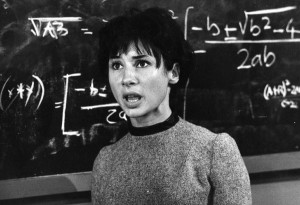
When our family gathers to watch the latest episode of Doctor Who on a Saturday evening, there will often come a point when one of the younger Slades rolls his eyes and says, to general approval: “Clara is so annoying.”
You might be tempted to dismiss this as a sexist reaction to the fact that the show features a strong-willed, decisive woman in a key role. But I don’t think it’s that.
I think Doctor Who‘s show-runner Steven Moffat is not quite managing to pull off one of the very tricky tasks facing a Who writer in the 21st century, which is this: How do you make the Doctor’s companion strong, interesting and driven without overshadowing the Time Lord himself?
Plenty of people seem to think that in the show’s original run, Doctor Who‘s companions were mini-skirted airheads who did nothing but put the Doctor to the inconvenience of explaining the plot and rescuing them. Sometimes they really were like that, but there was usually more going on.

At the start, Doctor Who – a rare example of an early 1960s TV show produced by a woman – featured a super-intelligent teenager and a confident schoolteacher as two of its four central characters. The show’s creators seemed to aspire to some sort of sex equality, even if the finished product did not always deliver. Carol Ann Ford, who played the Doctor’s granddaughter Susan from episode one, said in a Guardian interview: “When the part was first suggested to me, they said I was going to have the physicality of an Avengers girl, with all sorts of extraordinary powers. I’d have happily done anything they flung at me, but none of that happened … They did put it into the script that Susan was the Doctor’s equal, and she was even meant to be capable of flying the Tardis, but I was never allowed to do more than flick the odd switch.”
In the 1970s, third Doctor Jon Pertwee was teamed with the glamorous Jo Grant (Katy Manning). Critics have made much of the fact that, in her first episode, Jo claimed to have taken an A-level examination in science, only to admit later in the story that she hadn’t passed it. But that exchange aside, the show in the 1970s presented us with a succession of strong women.
There was journalist Sarah Jane Smith (Elisabeth Sladen), a creditable companion for the era of women’s lib; Leela (Louise Jamieson), who came from a warrior race and often had to be held back from killing people; and two incarnations of Romana, who really was the Doctor’s equal, because she came from his species. We can probably gloss over the companions who followed, because by the 1980s, hardly anyone one was watching anyway.
When the show returned in 2005, the role of the companion Rose was vital. Writer Russell T. Davies knew the character could help bring young women to the audience, and he cast Billie Piper, a former pop star who had turned out to be a very good actress. Rose was a shop worker whose career prospects on Earth didn’t seem to be all that bright, but who had the mettle to take marauding aliens in her stride. Rose, like the two further companions Davies created, was an ordinary person with a special strength of character which led the Doctor to choose her.
In Moffat’s era, the interpersonal relations have become cruder. The romantic elements of Davies’ era gave way to outright innuendo in the Matt Smith era, while the companions became increasingly abrasive. Amy Pond, the recurring character River Song and current assistant Clara Oswald, all developed a habit of dispensing put-downs to belittle the Doctor, and Clara has even threatened to slap him. (Would we consider it OK if the Doctor threatened to slap her?)
What’s more, Moffat’s love of season-long story arcs and big mysteries has unbalanced things further. While he has teased us with promises to reveal the Doctor’s name, or to show how the Doctor will die, we all know that the show cannot possibly deliver those things, so Moffat has to cheat his way out of them. In place of a resolution to those questions, he has focussed on big revelations about the companions – thereby making those characters sometimes seem more important than the Doctor himself.
The companions to Moffat’s Doctor are not ordinary people who do great things; instead, they seem to have been born to save the universe. Amy Pond turned out, after much build-up, to be the mother of the Doctor’s mysterious extra-terrestrial old flame River Song. And Clara, who was described as the ‘impossible girl’ because she seemed to crop up at drastically different times and places, eventually seemed to be practically immortal. The episode ‘The Name of the Doctor’ had Clara entering the Doctor’s time stream and appearing at multiple points in his history to save all his incarnations from danger – which when you think about it, meant that she was now the most important figure in the history of the show, including the Doctor himself.
The current season has been teasing the audience with the prospect that Clara might leave the show. But as the character considers parting company with the Doctor, she isn’t just acting on her own behalf. At least once this series, she has appointed herself to speak for the entire human race in telling him to go away and stop saving the planet. Is it any wonder some are finding her irritating?
The job of writing Doctor Who must present some almost insoluble problems for its show-runner – and getting the companions right is surely among the hardest of those. But at the moment, the show too often seems to be focused on the wrong character.
This is a shame, because Peter Capaldi’s performance often gives us signs that he could be the Time Lord’s best incarnation yet, if the Doctor were allowed to be the star of his own show. When the series raises the possibility that Clara may be set to depart, my own household can’t be the only one rooting for her to go.











1 Comment